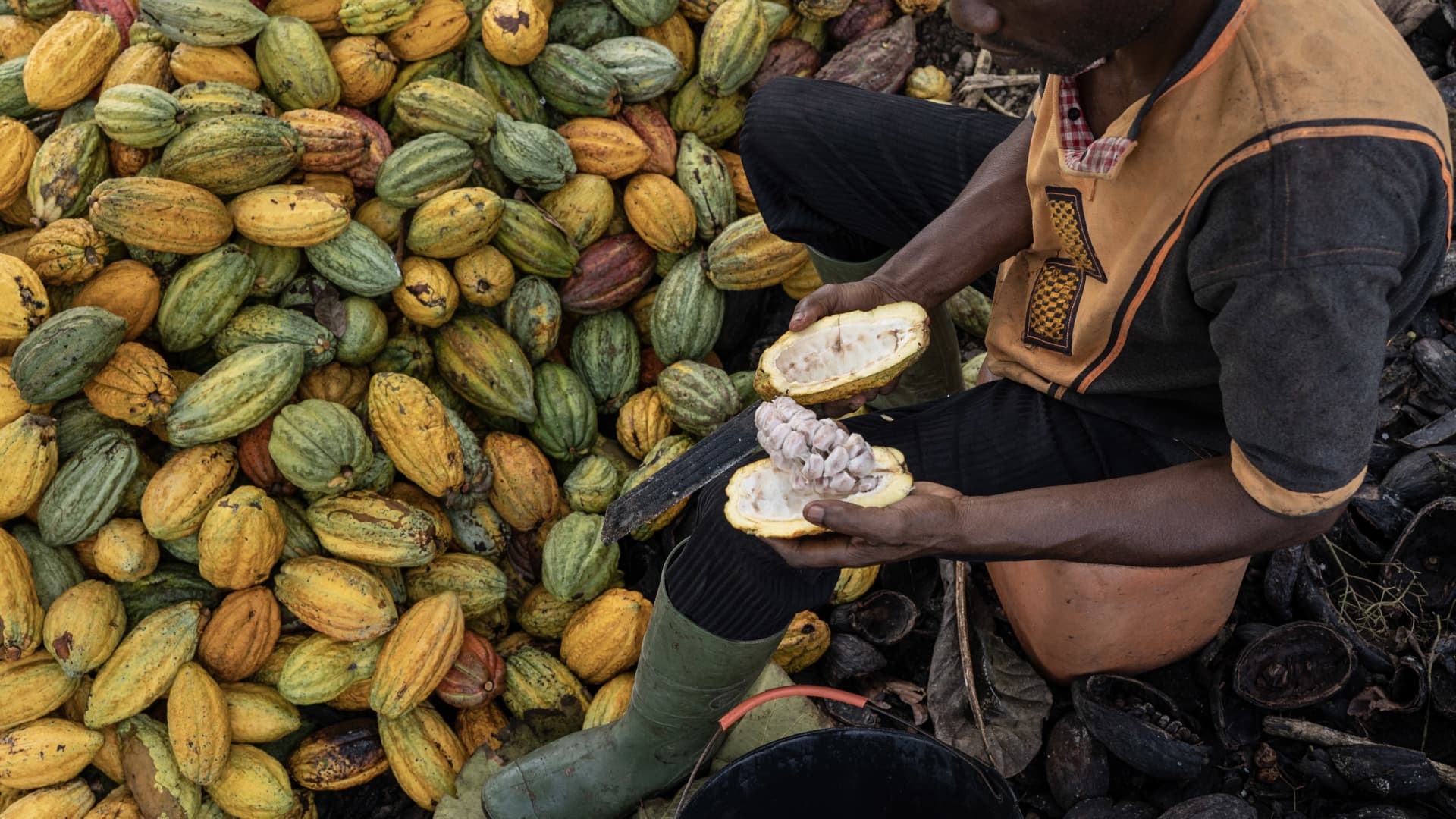A farmer cutting a cocoa pod to collect the beans inside on a farm in Azaguie, Ivory Coast, on Friday, Nov. 18, 2022.
Bloomberg | Bloomberg | Getty Images
Surging prices for soft commodities, from orange juice to live cattle, are complicating the inflation picture.
A variety of agricultural commodities have surged in recent months due to weather-related damage and rising climate risks worldwide, leading to tighter supplies. These higher prices add another layer of burden to consumers’ budgets at a time when core inflation stood at 4.3% in August, excluding food and energy expenses.
Futures contracts for orange juice, live cattle, raw sugar, and cocoa have all reached their yearly highs this month. According to Paul Caruso, director of commodity investments at Ancora, all of them are currently experiencing “supply-driven bull markets.”
The S&P GSCI Softs index, a sub-index of the S&P GSCI commodities index that exclusively measures soft commodities, has already surged over 18% this year.
The spike in orange juice prices can be attributed to a global citrus shortage and hurricanes that hit Florida last fall. Florida is the primary orange juice producer for the U.S., but major exporters like Brazil and Mexico have also lowered their orange crop yield estimates this year due to warmer temperatures impacting harvests.
The juice futures market reached a record $3.50 per pound this month. Similarly, live cattle futures reached a record of $1.9205 per pound.
Rising meat prices are driven by shrinking U.S. cattle herds, consistent beef demand, and increased labor and fuel costs. A prolonged drought in the Midwest earlier this year damaged grasslands and hay crops, forcing some farmers to reduce their herds. The U.S. Department of Agriculture predicts declining supplies this year and potentially in the coming years before recovery.
Not only breakfast and lunch have become more expensive, but also desserts.
Raw sugar and cocoa prices have soared in recent months. Sugar futures reached 27.62 cents per pound, the highest since 2012, while cocoa futures reached $3,763 per metric ton, the highest level in over a decade.
Price increases for sugar were caused by rising demand and downward crop revisions in key producing countries due to extreme weather. India, for instance, is the world’s second largest sugar producer after Brazil.
Darwei Kung, head of commodities and natural resources at DWS, explained that “soft commodities, in particular, are very vulnerable and sensitive to changes in weather.” Disruptions in production can lead to price hikes, and there is no quick solution as production capacity is limited. Kung also noted that consumers may experience higher prices than what central banks consider in their inflation calculations, leading to a discrepancy in perspectives on inflation.
Consumers are feeling the impact of higher prices as major food companies attempt to pass on their increased input costs.
“It’s definitely not the time to discuss deflation or price reductions due to the significant decrease in gross margin… We still face substantial input cost inflation,” stated Nestlé’s chief financial officer François-Xavier Roger at the Barclays Consumer Staples Conference earlier this month.
Roger highlighted increased costs for sugar, cocoa, and Robusta beans for coffee. He emphasized that while there have been declines in energy and transportation costs, the overall impact on input costs still leads to inflation in 2023.
Unilever’s chief financial officer Grame David Pitkethly also acknowledged inflation in the company’s nutrition and ice cream categories. In late July, Unilever reported a 12.6% rise in “underlying prices” within nutrition and 11.5% within ice cream. Pitkethly stated that although private label options are attractive to consumers in the ice cream category, the company is still experiencing inflation.
On a positive note, corn and wheat prices have fallen from their earlier highs this year, offering some relief for consumers.
Benchmark soybean futures fell to a one-month low last week after the USDA reported weaker-than-expected soy export sales. Corn and wheat reached their yearly highs in January and February but have since declined.
Some analysts believe that higher interest rates and a slower economy may curb consumer demand.
“Volatility will likely persist as we assess the harvest, but the real driver is understanding the demand,” said Jeff Kilburg, founder and CEO of KKM Financial.
Kilburg added that if demand weakens, it could potentially signal a pullback in stocks.
Denial of responsibility! Vigour Times is an automatic aggregator of Global media. In each content, the hyperlink to the primary source is specified. All trademarks belong to their rightful owners, and all materials to their authors. For any complaint, please reach us at – [email protected]. We will take necessary action within 24 hours.


